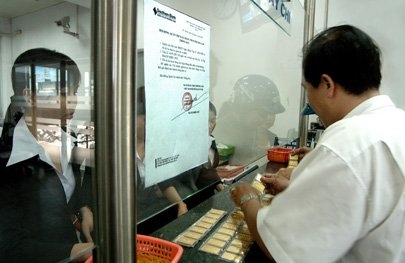Gold deposit rates pick up again
 Saigon Commercial Bank (SCB) quotes its gold deposit rate at 1.4 per cent a year. However, clients calling to a branch in Ho Chi Minh City are offered a rate of 2.5 per cent for one-month deposits of over 20 taels, provided that they will not withdraw their gold before maturity.
Saigon Commercial Bank (SCB) quotes its gold deposit rate at 1.4 per cent a year. However, clients calling to a branch in Ho Chi Minh City are offered a rate of 2.5 per cent for one-month deposits of over 20 taels, provided that they will not withdraw their gold before maturity.
If depositors did not withdraw their gold when the ban on gold lending and mobilisation comes into force on November 25, the bank would keep the precious metal for them at a fee but the interest rate would remain unchanged.
As for deposits of fewer than 20 taels, the mobilisation rates are a little higher than 1.4 per cent.
Meanwhile, at VietABank, gold deposit rate stands at 1.4 per cent for one-month terms, provided that clients will not withdraw their gold before maturity.
The rates at ACB remain at 1.4 per cent for one-month deposits of below 10 taels and 1.6 per cent for bigger deposits, which have been applied since September 11. Before that, gold deposit rates were lower than 1 per cent per year.
A banker in the city said credit institutions were mobilising gold for three purposes. Some banks have sold the gold deposited by their clients to stabilise the market upon request of the central bank and are now in need of gold to return to depositors.
Some others have short sold the precious metal at low prices, but now they are afraid gold prices will keep rising, so they boost gold purchase and mobilisation.
In addition, there are several banks having granted gold loans guaranteed by collateral. However, they have yet to collect the gold debts, with some having turned into bad debts, and thus also face gold shortage.
He said his bank was in the third case. The bank is still lacking tens of thousands of taels, so it is expected that his bank will be allowed to keep mobilising gold to deal with the liquidity shortage, he said.
Gold mobilisation is a common solution adopted by the banks facing the lack of gold liquidity, whereas at the other banks, this activity has ended for long.
Nguyen Hoang Minh, deputy director of the central bank’s branch in Ho Chi Minh City, deemed the mobilisation trend understandable, helping banks cope with their demand for gold.
He informed SJC had processed some 80,000 taels of gold of the total 350,000 taels to be processed around this time.
A senior source from a big bank said gold mobilisation was aimed at solving the liquidity problems, not generating more profits for banks. Therefore, banks cannot raise their deposit rates sharply and there will hardly be a race to hike gold deposit rates.
Despite the higher deposit rates, mobilising gold is not an easy task, as citizens are used to depositing gold fixedly at certain places. The source said the volume of gold deposited at his bank had been falling since the year’s beginning.
The amount of gold traded at SJC has been dropping sharply since early this month, from 5,000-6,000 taels a day in September to only 1,000-2,000 taels now. Nguyen Cong Tuong, deputy sales manager of SJC, said the gold demand still exceeded supply, so the gap between local and global gold prices were widening.
Local gold prices on Monday were VND3.3 million per tael higher than the world’s prices, the biggest gap in the year to date. Gold selling price quoted at SJC on Monday was VND47.23 million per tael, down VND500,000 against last weekend.
What the stars mean:
★ Poor ★ ★ Promising ★★★ Good ★★★★ Very good ★★★★★ Exceptional
Related Contents
Latest News
More News
- Securing capital and efficiency for Vietnam’s 2026-2030 growth ambitions (December 17, 2025 | 10:00)
- Energy sector in need of blended finance mechanisms (December 17, 2025 | 09:00)
- Vietnam still has room to mobilise capital for sustainable growth (December 17, 2025 | 08:57)
- Long-term capital seen as key hurdle to green growth (December 16, 2025 | 08:00)
- Gold prices swing amid tax debate and import uncertainty (December 15, 2025 | 18:04)
- Agribank frames bank credit as catalyst for green growth (December 15, 2025 | 17:59)
- Vietnam’s green transition demands collective financial action (December 15, 2025 | 12:00)
- VIR workshop highlights capital and policy for sustainable development (December 15, 2025 | 11:00)
- Promoting digital assets initiative in Vietnam (December 13, 2025 | 09:30)
- Experts flag gaps as national financial strategy under review (December 12, 2025 | 15:13)

 Tag:
Tag:





















 Mobile Version
Mobile Version